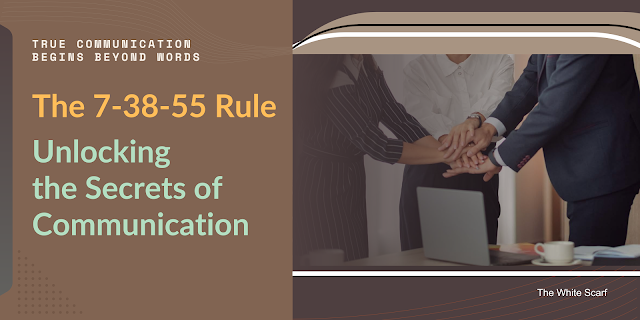Unlocking the Secrets of Communication: What is the 7-38-55 Rule?
Introduction
Have you ever had a conversation where someone said, "I'm fine," but you just knew they weren’t? That gut feeling may actually be backed by science, specifically, a communication theory known as the 7-38-55 Rule.
What Is the 7-38-55 Rule?
Developed by psychologist Albert Mehrabian, the 7-38-55 Rule explains how we interpret emotions in face-to-face communication.
Albert Mehrabian introduced the 7-38-55 Rule based on findings from his research conducted in the late 1960s. The rule stems from two key studies published in:
- 1967: Inference of Attitudes from Nonverbal Communication in Two Channels
- 1971: His book Silent Messages, where he summarized and explained the findings more broadly.
So, while the concept was developed through research in 1967, the 7-38-55 Rule became widely known after the publication of Silent Messages in 1971.
According to this theory:
🗣️ 7% of the message comes from the actual words spoken🎙️ 38% comes from the tone of voice (pitch, volume, and inflection)
👀 55% comes from body language and facial expressions
In short, a staggering 93% of emotional meaning is communicated nonverbally.
A Quote from Mehrabian Himself
“When there is inconsistency between attitudes communicated verbally and nonverbally, people tend to rely more on the nonverbal message.”
— Albert Mehrabian
Real-Life Examples of the 7-38-55 Rule in Action
Here are a few examples where this rule really shines:
👔 Job Interview
A candidate says, “I’m very confident in my skills,” but avoids eye contact, slouches, and speaks in a low tone. The interviewer might sense a lack of confidence, despite the words.
🛍️ Customer Service
A representative says, “I’m sorry for the inconvenience,” but uses a flat tone and sighs. The customer is unlikely to feel that the apology is genuine.
💞 Personal Conversation
Your partner says, “Nothing’s wrong,” but has crossed arms and avoids looking at you. Chances are, you’ll trust the body language over the words.
What the 7-38-55 Rule Doesn’t Mean
Myth-Busting Sidebar: What the Rule Is Not
- ❌ It doesn’t apply to written or factual communication.
- ❌ It doesn’t mean that words don’t matter, they do!
- ❌ It’s not a universal rule for all communication.
- ✅ It applies only when there's a mismatch between words and nonverbal signals—usually in emotional contexts.
Why This Rule Still Matters Today
In an increasingly digital world, much of our communication happens over text or video. Without tone and body language, it’s easy to misread emotional cues, leading to misunderstandings.
When you’re face-to-face or on video, being mindful of your tone and body language helps you come across as more sincere, confident, and trustworthy.
Tips for Better Emotional Communication
If you want to communicate more effectively, especially when emotions are involved, keep these simple tips in mind:
- Make eye contact when expressing sincerity.
- Relax your posture to appear more open and confident.
- Use a tone that matches your message.
- Smile when appropriate, it encourages connection.
- Avoid crossed arms or fidgeting if you want to appear calm and engaged.
Bonus: SEO-Friendly Key Phrases to Remember
These might help boost your post’s visibility:
- "How to improve emotional communication"
- "Importance of nonverbal communication"
- "Body language and tone in communication"
- "Mehrabian’s 7-38-55 rule explained"
Final Thought
Next time you want to communicate clearly, especially about how you feel, remember: it’s not just what you say, but how you say it.
Have you ever been in a situation where someone’s tone or body language told you more than their words? Share your story in the comments below!


